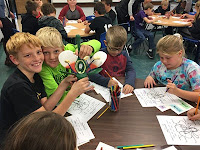Pollinator Power Activity
Cassie Homan, Horticulture Agent
One of my favorite parts of my job is getting to work with youth through 4-H and school programs. An elementary school, youth enrichment class I teach is called pollinator power. In this lesson we learn the parts of the flower and discuss why pollinators are so important. This is a lesson that we can all do at home! It’s a fun way to learn a bit of science while getting a little messy and learning some important information.Activity:
Start the lesson by asking kids to think about gardening. What are some things the garden needs to grow? This is the same for flowers. Flowers need water, soil, and sunlight to bloom. Did anyone mention bees? Flowers also need insects to help pollinate their blooms. Bees and pollinators are very important! Can you think of different types of pollinators? Think about butterflies, birds, bats, humans, and wind or water.
Fun Fact about Pollinators:
-About 1/3 of our diets are from insect pollinated plants
-80% of insect crop pollination is accomplished by honeybees
Think about what you recently ate for breakfast or lunch. What foods might have been pollinated by insects?
I like this short video to describe pollination. They also start to talk about the parts of a flower, which is the next step in the lesson.
Like Fruit? Thank a Bee YouTube Video: https://www.youtube.com/watch?v=txv2k7OoY7U&t=75s
Let’s Learn the Parts of a Flower:
Ask students to think of what a flower is made up of. Some answers might be stem, petals, roots, and leaves. If the flower you are using has these parts go ahead and identify them. Some flowers also have baby leaves called sepals. They are right at the base of the flower and they protect the flower when it is small.
Today we will see that some flowers have different male and female parts. This is how pollination occurs.
Male Part of the Flower is called the- Stamen the stamen is made up of two parts the filament and the anther.
filament: is the stalk that holds the anther and attaches it to the flower
anther: (pollen grains) –this is the pollen producing part of the plant, which will hopefully be transferred to the female part of the flower by wind, animals, or insects
Female Part of the Flower is called the- Pistil the pistil is made up of three parts the stigma, style, and ovary.
Stigma: this is the head of the pistil and looks like a sticky bulb on a long stalk in the center of the flower- it receives the pollen grains
Style: is the stalk that the stigma sits on top of
Ovary: the oval shaped ovary is in the middle of the flower. It is usually at the base of the style- where the seed develops
Below is a link for a worksheet on the parts of a flower. It might be best to practice learning the parts on the worksheet before dissecting the real flower. You can also Google parts of a flower worksheets and find lots of options!
https://www.havefunteaching.com/resource/science/plants/flower-parts-of-a-plant-worksheet
Explanation of Pollination-
When a plant is pollinated, the pollen that has landed on the stigma, reaches down through the style to the ovary. When the pollen tube reaches the ovary, it can be fertilized by the pollen. Then the ovules become seeds, and the ovary swells.
- We eat the seeds of many plants! Think of: corn, beans, sunflowers
- We also eat many fruits, which are the enlarged ovaries that contain the seeds of the plant. Like: Apples, Peaches, Avocados
Dissecting the Flower Activity:
Carefully pull the flower apart to find the many pieces of the flower. You can use a piece of paper and layout each part then label the pieces. Slowly pull apart the flower and be gentle so you don’t break any of the pieces.













